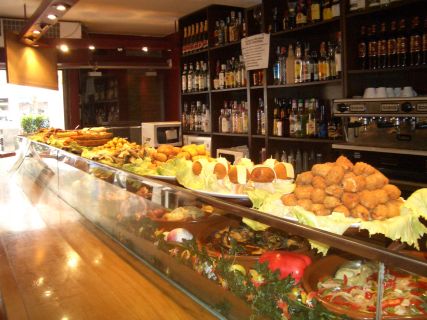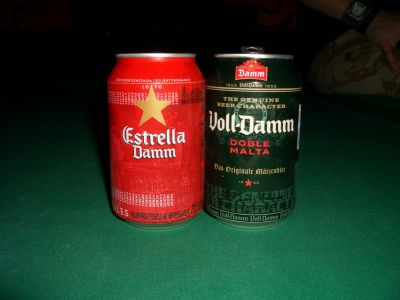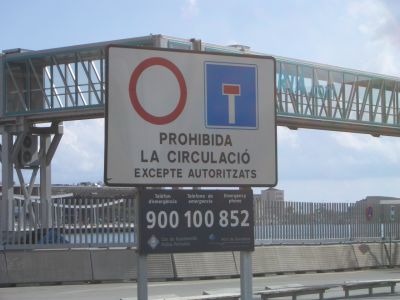October 1st, 2006
When most American diners think of tapas, the sumptuous Spanish small-plate selections, they picture a romantic candle-lit room of terra cota walls, white table cloths, and a bill fit for Rey Juan Carlos. Indeed, that does typify the American Spanish restaurant. Wonderful yet unfilling food, followed by a collossal bill for truly shrimpy gambas al ajillo.
However, like most immigrants making the westward passage across the Atlantic, tapas left behind much humbler origins. Spain is a hot, fly-ridden place, especially in the south, and the tapas tradition came into being as an early way to guard against the flies and other buzzing annoyances that come with the warm climate. To protect a fruity glass of sangria or cerveza, bartenders would cover the top with a small piece of bread. Over time, some places would add a small bite of food to the "lid" — or in Spanish, la tapa. Everyone loves free food, so the tradition caught on.
 Spain's attitude towards tapas still bears the marks of this early history, though the food moved from the top of the glass to a plate. Tapas are often eaten standing up at a bar, and rarely cost more than two Euros (except in generally expensive places like Barcelona or touristy areas). They're not fancy-schmancy building blocks to a meal, and Spaniards will normally eat just a few tapas before heading out to the real meal at another location. While delicious food, and sometimes exquisitely prepared, at heart they are small, cheap snaks, made with the happy disdain for "healthy food" appropriate for the extremely fit nation that invented mayonaise.
Spain's attitude towards tapas still bears the marks of this early history, though the food moved from the top of the glass to a plate. Tapas are often eaten standing up at a bar, and rarely cost more than two Euros (except in generally expensive places like Barcelona or touristy areas). They're not fancy-schmancy building blocks to a meal, and Spaniards will normally eat just a few tapas before heading out to the real meal at another location. While delicious food, and sometimes exquisitely prepared, at heart they are small, cheap snaks, made with the happy disdain for "healthy food" appropriate for the extremely fit nation that invented mayonaise.
The closest aproximation in the US is the Taco Bell value menu. Tell that to your tuxedo-clad waiter next time he corrects your pronunciation of Estrella.

October 1st, 2006
 Timing is everything. Almost exactly three years ago, I was in Barcelona. At the time I was blown away by the city, partially because as soon as I arrived it launched into the festivities of La Mercé. The city's biggest festival, it lasts four days, all day and all night, with continuous live music performed on outdoor stages, parades, gegantes, and a generally festive mood. Imagine my excitement when I learned that the same feste would be going on during this year's visit, by no intentional planning of my own.
Timing is everything. Almost exactly three years ago, I was in Barcelona. At the time I was blown away by the city, partially because as soon as I arrived it launched into the festivities of La Mercé. The city's biggest festival, it lasts four days, all day and all night, with continuous live music performed on outdoor stages, parades, gegantes, and a generally festive mood. Imagine my excitement when I learned that the same feste would be going on during this year's visit, by no intentional planning of my own.
The parades bear no resemblance to what I was used to thinking of as a parade. I picture what we have in the US, the somber, serious, sometimes sad processions of the Fourth of July or Memorial Day. I picture the surly high school students in the marching band simpering cynically down the street, the soporific strains of John Phillips Souza sounding out, sometimes in sync, more often not.
 No, there is no trace of somberness or cynicism in the Barcelona parades. They are fun, joyous events, for all ages. From the small children throwing confetti in strangers faces by the light of street lamps to the students in the local liceo tooting happily on their musical instruments and banging enthusiastically on their drums, to the oldest citizen raising a can of beer that he bought from some guy on the street corner. These people are full of energy, and they know how to have fun.
No, there is no trace of somberness or cynicism in the Barcelona parades. They are fun, joyous events, for all ages. From the small children throwing confetti in strangers faces by the light of street lamps to the students in the local liceo tooting happily on their musical instruments and banging enthusiastically on their drums, to the oldest citizen raising a can of beer that he bought from some guy on the street corner. These people are full of energy, and they know how to have fun.
How can you not have fun when marching and dancing with gegantes? These "giants" are double-to-triple-life-size papier-mache creations. Big burly men carry them through the city, making them spin and dance to the music. They are at once noble and comical. And they're everywhere.
Then you have the Castellers. This took my breath away the first time I saw it. Human castles made by standing one upon another's shoulders, up to dizzying heights. The photographs cannot capture the tenseness and excitement as the castells are being constructed, one layer at a time. The base of the castle is a ring of more big burly men, with each succeeding level getting smaller and smaller, until the top person I swear must be two years old. They climb the tower of people, sometimes seven or eight lengths high, with no apparent fear and perfect agility. I have seen one or two topples (although not this year), so that makes it all the more impressive.
I don't think I slept for more than an hour per night while the celebrations were going on. If you're ever in Catalonia during the end of September, be sure to stop by Barcelona for the Feste de la Mercé. And say hi to the gegantes for me.

October 5th, 2006
Here are some leftover thoughts that didn't make it into the first entry about Barcelona.
The Metro here – the subway – is designed for lefties. The place to enter the ticket is to the left of the turnstile. This caused me no end of confusion when I tried to walk through the wrong turnstile for about thirty seconds until somebody pointed out my mistake. Ned Flanders would like it here.
While in most subways, the doors open automatically as soon as the car stops, in both Madrid and Barcelona, the doors on the Metro cars don't open until somebody presses a button or turns a lever, so the first person in line has that responsibility. I don't know why this is the case, but it too caused me some trouble when I stood there waiting and wondering why the door didn't open.
 Barcelonans are very proud of their Catalonian heritage and the Catalan language. When I was here three years ago, the street signs were in Castillian Spanish, with Catalan sometimes underneath. Now, they're only in Catalan. It's sort of the opposite of what takes place in the United States. In the US, immigrants often intentionally leave behind their home languages in order to better assimilate. In many parts of Europe, including Ireland, the Basque country, and Catalonia, old languages are being brought back. The common factor in these locations is that they are languages that were suppressed; in Ireland, by the English, in Spain, by General Franco.
Barcelonans are very proud of their Catalonian heritage and the Catalan language. When I was here three years ago, the street signs were in Castillian Spanish, with Catalan sometimes underneath. Now, they're only in Catalan. It's sort of the opposite of what takes place in the United States. In the US, immigrants often intentionally leave behind their home languages in order to better assimilate. In many parts of Europe, including Ireland, the Basque country, and Catalonia, old languages are being brought back. The common factor in these locations is that they are languages that were suppressed; in Ireland, by the English, in Spain, by General Franco.
Tapas, or Pintxos, as the Barcelonans call them, are more elaborate and more expensive in Barcelona than they are in other parts of Spain.
It's very hot everywhere, even in so-called air conditioned locations. I guess they didn't get the memo from Miami that when it's hot outside it's supposed to be frigid indoors. It's late September, and it's still hard for me to get used to the heat. Strangely, Spaniards seem to never wear shorts. They must have thinner blood than I do.
There are tons of street performers in Barcelona. Some of them are very talented musicians or jugglers or what-not, but others seem to be lacking in the talent department. There is an entire section of Las Ramblas populated by "performers" who do nothing but dress in funny costumes and just stand there. Some of them are good at standing stock-still and surprising passerbys. Some do little dances and make faces. Others just look bored, as I imagine I would be, too. They must make a living at it, though, since there is no shortage of them. It's good to know if the whole software-engineering thing doesn't work out, I can always dress as a Leprechaun and stand on a streetcorner for money.
 Spain's attitude towards tapas still bears the marks of this early history, though the food moved from the top of the glass to a plate. Tapas are often eaten standing up at a bar, and rarely cost more than two Euros (except in generally expensive places like Barcelona or touristy areas). They're not fancy-schmancy building blocks to a meal, and Spaniards will normally eat just a few tapas before heading out to the real meal at another location. While delicious food, and sometimes exquisitely prepared, at heart they are small, cheap snaks, made with the happy disdain for "healthy food" appropriate for the extremely fit nation that invented mayonaise.
Spain's attitude towards tapas still bears the marks of this early history, though the food moved from the top of the glass to a plate. Tapas are often eaten standing up at a bar, and rarely cost more than two Euros (except in generally expensive places like Barcelona or touristy areas). They're not fancy-schmancy building blocks to a meal, and Spaniards will normally eat just a few tapas before heading out to the real meal at another location. While delicious food, and sometimes exquisitely prepared, at heart they are small, cheap snaks, made with the happy disdain for "healthy food" appropriate for the extremely fit nation that invented mayonaise.

 Timing is everything. Almost exactly three years ago, I was in Barcelona. At the time I was blown away by the city, partially because as soon as I arrived it launched into the festivities of La Mercé. The city's biggest festival, it lasts four days, all day and all night, with continuous live music performed on outdoor stages, parades, gegantes, and a generally festive mood. Imagine my excitement when I learned that the same feste would be going on during this year's visit, by no intentional planning of my own.
Timing is everything. Almost exactly three years ago, I was in Barcelona. At the time I was blown away by the city, partially because as soon as I arrived it launched into the festivities of La Mercé. The city's biggest festival, it lasts four days, all day and all night, with continuous live music performed on outdoor stages, parades, gegantes, and a generally festive mood. Imagine my excitement when I learned that the same feste would be going on during this year's visit, by no intentional planning of my own. No, there is no trace of somberness or cynicism in the Barcelona parades. They are fun, joyous events, for all ages. From the small children throwing confetti in strangers faces by the light of street lamps to the students in the local liceo tooting happily on their musical instruments and banging enthusiastically on their drums, to the oldest citizen raising a can of beer that he bought from some guy on the street corner. These people are full of energy, and they know how to have fun.
No, there is no trace of somberness or cynicism in the Barcelona parades. They are fun, joyous events, for all ages. From the small children throwing confetti in strangers faces by the light of street lamps to the students in the local liceo tooting happily on their musical instruments and banging enthusiastically on their drums, to the oldest citizen raising a can of beer that he bought from some guy on the street corner. These people are full of energy, and they know how to have fun.
 Barcelonans are very proud of their Catalonian heritage and the Catalan language. When I was here three years ago, the street signs were in Castillian Spanish, with Catalan sometimes underneath. Now, they're only in Catalan. It's sort of the opposite of what takes place in the United States. In the US, immigrants often intentionally leave behind their home languages in order to better assimilate. In many parts of Europe, including Ireland, the Basque country, and Catalonia, old languages are being brought back. The common factor in these locations is that they are languages that were suppressed; in Ireland, by the English, in Spain, by General Franco.
Barcelonans are very proud of their Catalonian heritage and the Catalan language. When I was here three years ago, the street signs were in Castillian Spanish, with Catalan sometimes underneath. Now, they're only in Catalan. It's sort of the opposite of what takes place in the United States. In the US, immigrants often intentionally leave behind their home languages in order to better assimilate. In many parts of Europe, including Ireland, the Basque country, and Catalonia, old languages are being brought back. The common factor in these locations is that they are languages that were suppressed; in Ireland, by the English, in Spain, by General Franco.
